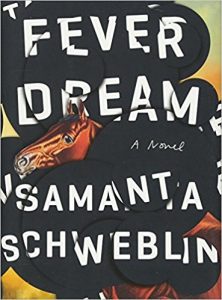Stefan Dziemianowicz reviews Fever Dream by Samanta Schweblin
Fever Dream, Samanta Schweblin (Riverhead 978-0-399-18459-8, $25.00, 192pp, hc) January 2017.
 The title of Samanta Schweblin’s
The title of Samanta Schweblin’s first novel novella, Distancia de rescate, translates as “the rescue distance,” the term a character uses to describe the amount of ground she would have to cover in order to reach her young daughter and whisk her away from danger. The title of the English-language edition of the book, however, is Fever Dream, which speaks to both to its theme and narrative style.
The book opens in mid-story with a conversation between a woman identified as Amanda, and David, an interlocutor whose speech displays in italics. Amanda is a vacationer to an unnamed rural countryside where she has befriended David’s mother, Carla, who relates her experience from five years earlier when David, her son, was accidentally exposed to what appears to have been toxic waste that has run off in a nearby stream. With David on death’s doorstep the desperate Carla gives him to a local healing woman who recommends “a migration,” or transfer of his spirit to another body: “If we could move David’s spirit to another body in time,” she says, “then part of the poison would also go with him. Split into two bodies, there was the chance he could pull through.” There’s only one drawback: no one knows whose body David’s spirit will end up in. The David talking with Amanda is, apparently, the physical shell of Carla’s son five years after the migration – the same amount of time for which Carla has completely disowned him.
At first it’s not entirely clear what is happening in Schweblin’s novella. Events toggle back and forth between the past of Carla’s ordeal with David and the apparent present in which the sympathetic Amanda listens while tending to her young daughter Nina. David interrogates Amanda attentively, seeking clues in her choice of words as she relates the story that Carla told her about his poisoning. The narrative compels reader attention to keep the two time frames separate and distinct from one another, a difficult task since it’s sometimes not clear from the profusion of pronouns used who is speaking or when. There’s also one genuinely creepy episode that Amanda describes involving Nina and David that Amanda belatedly dismisses as a recalled nightmare of hers, and not part of the running narrative that it seems to be. Portentous events also unfold on the periphery of the story, among them a scene of men unloading plastic barrels full of something from a truck and accidentally dropping one. The shifts of time and perspective, the indeterminacy of events, and the suggested supernaturalism of David’s spirit migration give the story the texture of the titular fever dream. But whose dream, and what has given rise to it?
Schweblin’s novella is one with a gradually expanding perspective. As the story proceeds and more details emerge, the focus on its events draws farther back and a bigger and grimmer picture emerges. At its center is the story of Carla, a mother driven to desperation to save the son whom she loves, and who, in doing so, loses him in a way that is emotionally devastating. That relationship proves the key to understanding how the story of David and Carla relates to the story of Amanda and Nina, and why David is asking Amanda the specific questions her puts to her regarding how Carla handled his poisoning and its aftermath. But even as Carla and David’s fate becomes more relevant to that of Amanda and Nina, the certainty of narrative events becomes more tenuous – especially once the reader learns where David is supposedly conversing with Amanda and what her condition is. Questions arise: How reliable is Amanda’s recollection of events? Did David’s soul migration really happen? Does David even exist outside of Amanda’s feverish imagination? Increasingly the narrative comes to seem an echo chamber in which memories within the consciousness of a single person find validation by conjuring people and events to justify them. Ultimately that’s what makes Schweblin’s novella so eerie and unsettling.
It’s worth pointing out that Schweblin’s novella was shortlisted this past April for the Man Booker International Prize, and deservedly so.
Stefan Dziemianowicz, Contributing Editor, is author of The Annotated Guide to Unknown and Unknown Worlds and a collection of re-told urban legends, Bloody Mary and Other Tales for a Dark Night, and editor (with S.T. Joshi) of three-volume reference work Supernatural Literature of the World: An Encyclopedia and of more than thirty anthologies including Bram Stoker Award-winning Horrors: 365 Scary Stories, Famous Fantastic Mysteries, and 100 Ghastly Little Ghost Stories. Between 1991 and 1999, he edited critical magazine Necrofile: The Review of Horror Fiction. His critical work on horror and fantasy fiction has appeared in Washington Post Book World, Lovecraft Studies, and other publications, and he is a regular contributor to Publishers Weekly.
This review and more like it in the October 2017 issue of Locus.








